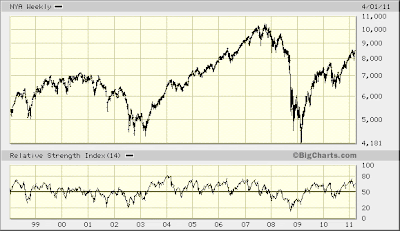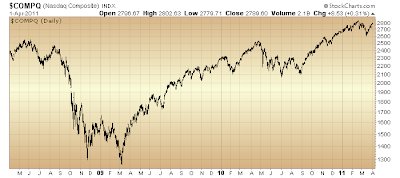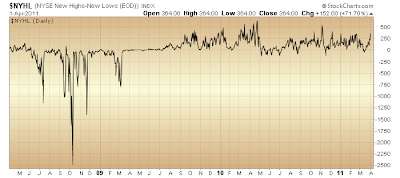The so-called "bull market" many on and off Wall Street are proclaiming to offer investors opportunities in what are termed "undervalued" common stocks is a bona fide fake. I am here today to prove it.
First, though, let me summarize for you the stock market's history. The spirit of it, in fact, is well-spoken in an old folk song called, "Where Have All the Flowers Gone?"
From flowers to graveyards, and back to flowers again. King Solomon, thousands of years earlier, similarly understood this was the way of things...
One generation passes away, and another generation comes; But the earth abides forever. The sun also rises, and the sun goes down, And hastens to the place where it arose. The wind goes toward the south, And turns around to the north; The wind whirls about continually, And comes again on its circuit. All the rivers run into the sea, Yet the sea is not full; To the place from which the rivers come, There they return again. All things are full of labor; Man cannot express it. The eye is not satisfied with seeing, Nor the ear filled with hearing. That which has been is what will be, That which is done is what will be done, And there is nothing new under the sun.So, too, the stock market's history. From flowers to graveyards, then to flowers yet again. There is nothing new under the sun. Indeed, this truth finds place in every human endeavoring. Now, this endless cycle of things in the stock market is driven by what are called "animal spirits" — blossoming stocks in its increase and sending prices to the grave when the spirit is vanquished. Since the stock market is a realm where money makes the world go round, the manner of its placement can tell you everything about the state of animal spirits. With this useful and proper perspective established, then, let me show you that, animal spirits these days rather clearly are waning. This trend, indeed, has become well-established over the past ten years. It warns of a stock market headed for the graveyard...
NYSE Composite Index

NASDAQ Composite Index
 When animal spirits are increasing there is a lot of love to go around. Listed stocks everywhere will be watered like flowers whose bloom their buyers both anticipate and desire. Stocks listed on the New York Stock Exchange, as well as those trading on NASDAQ's electronic exchange will flourish in unison. Indeed, animal spirits' increase will find those more speculative shares, such as are listed on NASDAQ, the bigger benefactor. Were animal spirits truly rising, this distinction simply must be present.
Yet what has been the way of things since Y2k? Where has the love been more faithfully given? Clearly, those more staid issues listed on the New York Stock Exchange have received more attention.
Of course, this stands to reason given macro circumstances making it imperative that, risk be migrated up the capital structure. No matter what schemes have been devised to increase money's availability — be it by a shadow banking system and its infinite multiplier, or by coerced bailout of this failed Ponzi scheme — animal spirits in the stock market have been left waning.
But wait, you demur! What about NASDAQ's relatively better performance of late? Indeed, its March '09 bottom failed to take out lows established in 2002, whereas the NYSE was not so fortunate. Furthermore, in percentage terms the NASDAQ Composite has risen far more strongly than has the NYSE since March 2009. Could this be indicating a return of animal spirits?
Indeed, it could be! Yet, in fact, it isn't...
When animal spirits are increasing there is a lot of love to go around. Listed stocks everywhere will be watered like flowers whose bloom their buyers both anticipate and desire. Stocks listed on the New York Stock Exchange, as well as those trading on NASDAQ's electronic exchange will flourish in unison. Indeed, animal spirits' increase will find those more speculative shares, such as are listed on NASDAQ, the bigger benefactor. Were animal spirits truly rising, this distinction simply must be present.
Yet what has been the way of things since Y2k? Where has the love been more faithfully given? Clearly, those more staid issues listed on the New York Stock Exchange have received more attention.
Of course, this stands to reason given macro circumstances making it imperative that, risk be migrated up the capital structure. No matter what schemes have been devised to increase money's availability — be it by a shadow banking system and its infinite multiplier, or by coerced bailout of this failed Ponzi scheme — animal spirits in the stock market have been left waning.
But wait, you demur! What about NASDAQ's relatively better performance of late? Indeed, its March '09 bottom failed to take out lows established in 2002, whereas the NYSE was not so fortunate. Furthermore, in percentage terms the NASDAQ Composite has risen far more strongly than has the NYSE since March 2009. Could this be indicating a return of animal spirits?
Indeed, it could be! Yet, in fact, it isn't...

 Contrasting the performance of the NASDAQ Composite with its cumulative Advance-Decline line, one can plainly see that, since March '09 bottom fewer NASDAQ-listed issues (and fewer still since late-summer 2010) have been the driving force behind the NASDAQ Composite's lift higher. Back in early-2008 when the NASDAQ Composite traded at current levels, its cumulative Advance-Decline line was far more positive than is presently the case.
So, yes, the NASDAQ Composite has smartly recovered. However, the greater bulk of NASDAQ-listed issues simply have not participated to any comparable degree.
The appearance that, a return of animal spirits is being evidenced by the NASDAQ Composite's strong advance off March '09 bottom (this in comparison to the NYSE Composite's advance over the same interim) is defied by narrowing upside participation of NASDAQ-listed issues.
Yet the clincher revealing that, the stock market's animal spirits are waning is seen via the cumulative Advance-Decline line of listed issues trading on the NYSE...
Contrasting the performance of the NASDAQ Composite with its cumulative Advance-Decline line, one can plainly see that, since March '09 bottom fewer NASDAQ-listed issues (and fewer still since late-summer 2010) have been the driving force behind the NASDAQ Composite's lift higher. Back in early-2008 when the NASDAQ Composite traded at current levels, its cumulative Advance-Decline line was far more positive than is presently the case.
So, yes, the NASDAQ Composite has smartly recovered. However, the greater bulk of NASDAQ-listed issues simply have not participated to any comparable degree.
The appearance that, a return of animal spirits is being evidenced by the NASDAQ Composite's strong advance off March '09 bottom (this in comparison to the NYSE Composite's advance over the same interim) is defied by narrowing upside participation of NASDAQ-listed issues.
Yet the clincher revealing that, the stock market's animal spirits are waning is seen via the cumulative Advance-Decline line of listed issues trading on the NYSE...

 My goodness, were the NYSE Composite tracking its cumulative Advance-Decline line, the index would be trading at record levels by now! Yet it presently trades well below its all-time high reached in October 2007.
Taken in isolation one could conclude that, NYSE-listed issues were pounded in large dollar increments going into March '09 bottom, and then bid up in smaller increments subsequently. That's why the NYSE Composite Index is languishing relative to the NYSE's fabulously increasing, cumulative Advance-Decline line.
This, by itself, is rather conspicuous. It reveals that, buying interest in NYSE-listed issues in fact is relatively tepid. Although undeniable success has been achieved in maintaining a broadly based, increasing bid on NYSE-listed issues, the consequence of this has been notably muted.
Per the matter of animal spirits, in contrasting NYSE and NASDAQ cumulative Advance-Decline lines we see prevailing the same foreboding circumstance as is revealed via performance disparities in the NYSE Composite versus the NASDAQ Composite since Y2k. The greater portion of love unquestionably is being given NYSE-listed issues. Thus, animal spirits are better seen waning.
Money can be made available until the cows come home, and in whatever ways this might be accomplished (fundamentally sound or otherwise). Yet if love toward common stocks this engenders does not lead to a broadening interest positively touching more speculative listed issues, then animal spirits are dying. Without these, eventually, prices all too likely will come under pressure and result in the stock market being buried.
Animal spirits — their presence or absence — measure a consensus judgment of whether common stocks are thought cheap or dear. At present we see the only thing "cheap" these days is all manner of talk claiming stocks are "undervalued" and "attractive." Money — its cumulative placement in the riskiest financial asset of all: common stocks — clearly indicates truth is judged otherwise.
Further indication that, animal spirits are waning is revealed by the differential of new 52-week highs and lows of listed issues trading respectively on the NYSE and NASDAQ...
My goodness, were the NYSE Composite tracking its cumulative Advance-Decline line, the index would be trading at record levels by now! Yet it presently trades well below its all-time high reached in October 2007.
Taken in isolation one could conclude that, NYSE-listed issues were pounded in large dollar increments going into March '09 bottom, and then bid up in smaller increments subsequently. That's why the NYSE Composite Index is languishing relative to the NYSE's fabulously increasing, cumulative Advance-Decline line.
This, by itself, is rather conspicuous. It reveals that, buying interest in NYSE-listed issues in fact is relatively tepid. Although undeniable success has been achieved in maintaining a broadly based, increasing bid on NYSE-listed issues, the consequence of this has been notably muted.
Per the matter of animal spirits, in contrasting NYSE and NASDAQ cumulative Advance-Decline lines we see prevailing the same foreboding circumstance as is revealed via performance disparities in the NYSE Composite versus the NASDAQ Composite since Y2k. The greater portion of love unquestionably is being given NYSE-listed issues. Thus, animal spirits are better seen waning.
Money can be made available until the cows come home, and in whatever ways this might be accomplished (fundamentally sound or otherwise). Yet if love toward common stocks this engenders does not lead to a broadening interest positively touching more speculative listed issues, then animal spirits are dying. Without these, eventually, prices all too likely will come under pressure and result in the stock market being buried.
Animal spirits — their presence or absence — measure a consensus judgment of whether common stocks are thought cheap or dear. At present we see the only thing "cheap" these days is all manner of talk claiming stocks are "undervalued" and "attractive." Money — its cumulative placement in the riskiest financial asset of all: common stocks — clearly indicates truth is judged otherwise.
Further indication that, animal spirits are waning is revealed by the differential of new 52-week highs and lows of listed issues trading respectively on the NYSE and NASDAQ...

 First, consider these measures in absolute terms. Despite both NYSE and NASDAQ Composite indexes having risen over the past year to new highs, post-March '09 bottom, the differential between listed issues hitting new 52-week highs and lows has in fact contracted. Were animal spirits increasing commensurately with the market's further advance over the past year, these measures would be expanding, not contracting.
Then, a noteworthy matter seen in relative terms finds persisting a rather muted number of issues leading the market's charge higher. Consider this within the context of the fact that, the vast majority of listed issues on both exchanges were beaten with an ugly stick in 2008, driven to levels that should have resulted in a fairly commensurate surge in the new 52-week high-low differential over the course of the market's advance off March '09 bottom, particularly since March 2010. There is no way of saying what "should" have registered, but something at least nearly double what has been seen does not seem the least bit unreasonable.
An objective assessment of the condition of animal spirits in the stock market substantiates my contention that, the consensus of interests neither finds common stocks "cheap" nor "attractive." This, I submit, is the truth of the matter irrespective of a seeming shortage of yield-bearing financial assets from which to choose. Granted, the bid currently underlying stocks probably exists largely on account of this disparity. Yet could any model driving investment capital into the stock market solely because yield is scarce really accomplish anything but diminish animal spirits further? Indeed, this consideration might go some way toward explaining why the differential between new 52-week highs and lows on the NYSE and NASDAQ has been shrinking over the past year.
Let me close with a rather revealing poll I came across today on CNBC's website, as it relates to this issue surrounding a seeming shortage of suitable, yield-bearing financial assets. The question was asked, "What is the best investment going forward this year?" Here are the results:
First, consider these measures in absolute terms. Despite both NYSE and NASDAQ Composite indexes having risen over the past year to new highs, post-March '09 bottom, the differential between listed issues hitting new 52-week highs and lows has in fact contracted. Were animal spirits increasing commensurately with the market's further advance over the past year, these measures would be expanding, not contracting.
Then, a noteworthy matter seen in relative terms finds persisting a rather muted number of issues leading the market's charge higher. Consider this within the context of the fact that, the vast majority of listed issues on both exchanges were beaten with an ugly stick in 2008, driven to levels that should have resulted in a fairly commensurate surge in the new 52-week high-low differential over the course of the market's advance off March '09 bottom, particularly since March 2010. There is no way of saying what "should" have registered, but something at least nearly double what has been seen does not seem the least bit unreasonable.
An objective assessment of the condition of animal spirits in the stock market substantiates my contention that, the consensus of interests neither finds common stocks "cheap" nor "attractive." This, I submit, is the truth of the matter irrespective of a seeming shortage of yield-bearing financial assets from which to choose. Granted, the bid currently underlying stocks probably exists largely on account of this disparity. Yet could any model driving investment capital into the stock market solely because yield is scarce really accomplish anything but diminish animal spirits further? Indeed, this consideration might go some way toward explaining why the differential between new 52-week highs and lows on the NYSE and NASDAQ has been shrinking over the past year.
Let me close with a rather revealing poll I came across today on CNBC's website, as it relates to this issue surrounding a seeming shortage of suitable, yield-bearing financial assets. The question was asked, "What is the best investment going forward this year?" Here are the results:
Cash 20% Bonds 2% Commodities 30% Stocks 47%Guess whose forecast for an upcoming stock market crash just got stronger! Out of 4037 votes only 2% think bonds are an attractive investment right now? Given the above choices, which do you think will be the superior performer were a "risk off" super tsunami to sweep across the globe, such as is made imminently likely by more vulnerability than can possibly be shielded by a bankrupt U.S. Federal Reserve? (Think U.S. Treasuries.)
* * * * *
© The Risk Averse Alert — Advocating a patient, disciplined approach to stock market investing. Overriding objective is limiting financial risk. Minimizing investment capital loss is a priority.
Analysis centers on the stock market's path of least resistance. Long-term, this drives a simple strategy for safely investing a 401(k) for maximum profit. Intermediate-term, investing with stock index tracking-ETFs (both their long and short varieties) is advanced. Short-term, stock index options occasionally offer extraordinary profit opportunities when the stock market is moving along its projected path.
Nothing is set in stone. Nor is the stock market's path of least resistance always known. More often than not, there are no stock index option positions recommended.
 There's an easy way to boost your investment discipline...
Get Real-Time Trade Notification!
There's an easy way to boost your investment discipline...
Get Real-Time Trade Notification!



















